FROM DIRT TO ASPHALT: MXA GOES FROM OFF-ROAD TO ON-ROAD ON THE 2025 KTM 450SMR SUPERMOTO
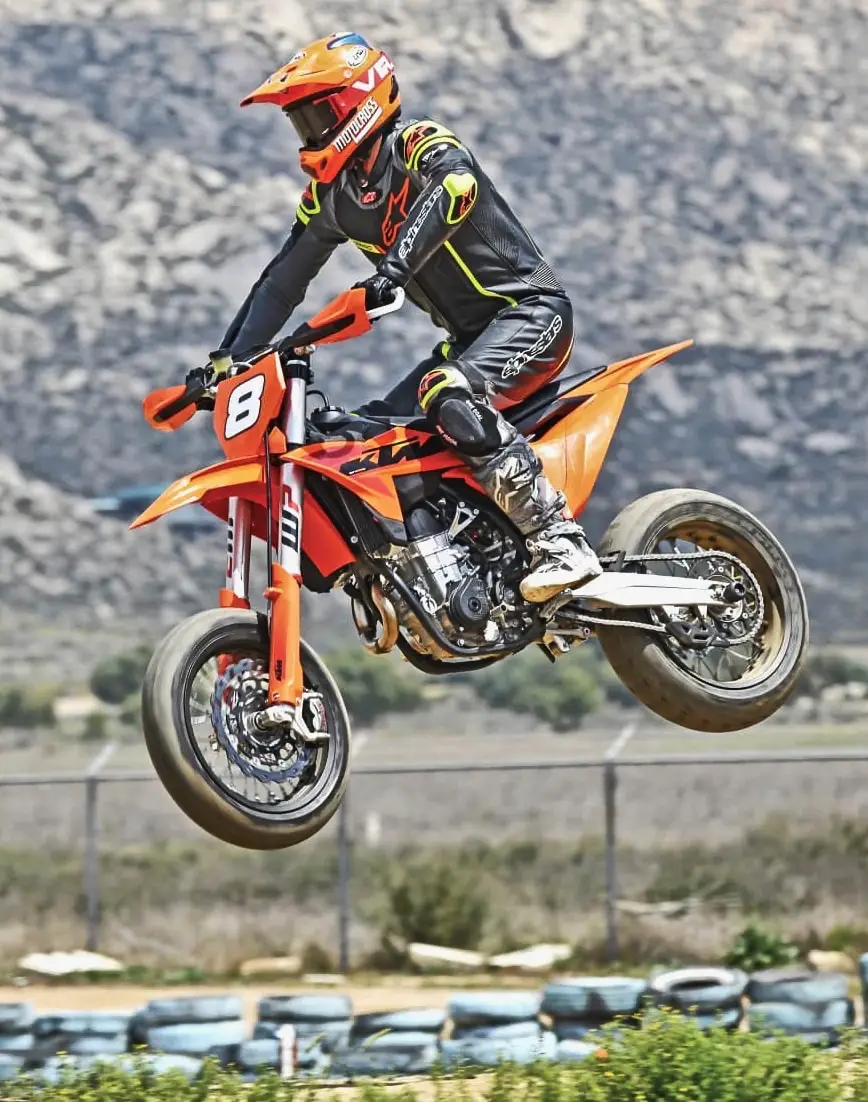 Jumping from dirt to asphalt is a seamless way to link the two tracks.
Jumping from dirt to asphalt is a seamless way to link the two tracks.
BY JUSTIN LEE
Coming from the world of professional motocross, I’ve spent my entire career mastering how to find control in chaos. Motocross teaches you to expect the unexpected—from changing terrain to deep ruts to unpredictable traction. There is a constant need to react on instinct. So, when I was hand-picked to ride the KTM 450SMR for the first time, I knew I was venturing into unfamiliar territory. I had never ridden a Supermoto bike before, and this bike was something different. It wasn’t a motocross bike with street tires; it was a purpose-built race machine. Thankfully, KTM brought their full-factory support crew, and everything was set up as if I were a factory racer.
THE KTM 450SMR IS KTM’S FLAGSHIP SUPERMOTO RACE BIKE. IT’S BASED ON THE 450SXF MOTOCROSS PLATFORM, BUT NEARLY EVERYTHING ABOUT THE BIKE IS REFINED FOR SUPERMOTO RACING.
The KTM 450SMR is KTM’s flagship Supermoto race bike. It’s based on the 450SXF motocross platform, but nearly everything about the bike is refined for Supermoto racing. From the moment I got on the bike and rolled onto the track, I could feel how precise and planted it was. Coming from dirt, I’m used to limited traction. The tires break loose, the ground moves underneath you, and you’re always working to stay ahead of the bike. The 450SMR was the complete opposite. The amount of traction it had on asphalt was insane. At first, it almost threw me off. I found myself expecting the tires to slip under hard braking or acceleration, but they never did. Instead, the bike held its line perfectly. That alone took me several laps to get used to.
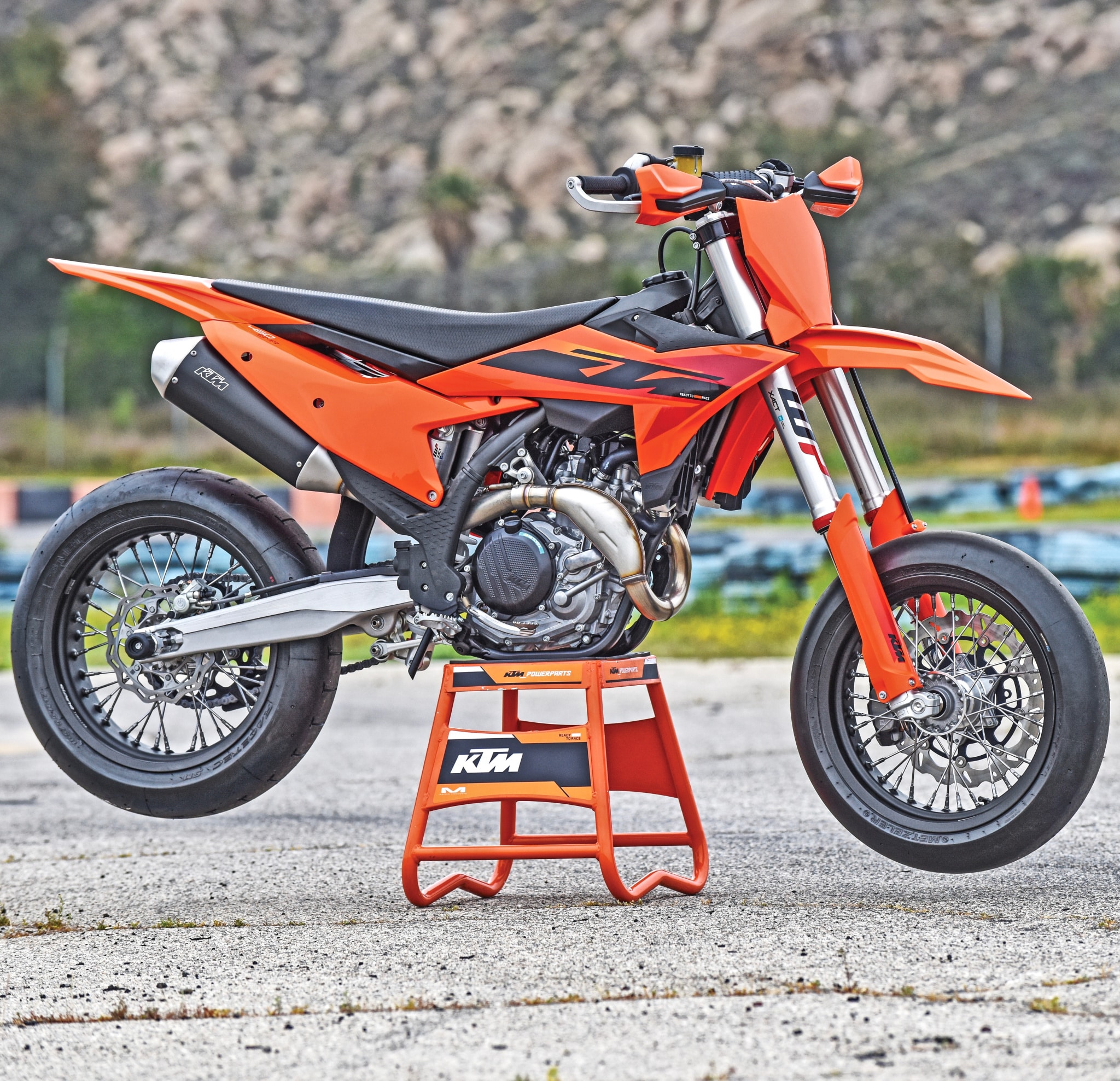
WHAT’S NEW ABOUT THE 2025 KTM 450SMR?
The KTM 450SMR is built off of the KTM 450SXF platform, so many aspects of this bike cross over. It has the same engine, and for 2025 the Supermoto bike has the same frame as well, with the shock-tower cutouts and revised linkage; however, there are some key differences between the Supermoto bike and the motocross model.
The Supermoto suspension is lowered to improve cornering, and it comes with 17-inch wheels front and rear rather than the 21-inch front and 19-inch rear that come on the motocrosser. Instead of Dunlop MX34 knobby tires, it has Metzeler Racetec SM K1 Supermoto tires wrapped around Alpina rims. Thanks to the wheels and suspension, the seat height and ground clearance are both down by 2-1/2 inches. The front brake is a four-piston design rather than the two-piston setup that comes on the motocross bike, and it works with an ultra-large 310mm brake rotor. For the first time on KTM’s Supermoto bikes, the 2025 KTM 450SMR has closed-circuit, 48mm, WP XACT spring forks. Of course, the clickers are adjustable by hand just like on the motocross models. The slipper clutch is a must in Supermoto because it helps retain rear-wheel traction entering corners instead of wheel hopping under deceleration and downshifting. The Supermoto footpegs are also smaller to prevent them from hooking on track curbing.
Thankfully, I didn’t get dropped off at a go-kart track to learn about Supermoto by myself. KTM showed up in full force to help introduce me to the world of Supermoto. Their professionalism was next level. One thing that stood out immediately was the tire warmers. While the bikes were on the stand, the KTM support crew used tire warmers to keep the rubber at a consistent 160 degrees. We’ve only recently begun to see this at Supercross races when the temperatures outside the stadiums are freezing, but tire warmers don’t do much for motocross. I learned quickly that on cooler days or during slower sessions, the tires would lose heat on the pavement and suffer a drop in air pressure. This would change the handling of the bike, so tire pressures had to be checked and adjusted after every single session. That kind of attention to detail made a big difference. Another small detail that impressed me was the way the mechanics would scrape the tires clean by hand after every outing. They removed built-up rubber from the wheels to keep the contact patch smooth and predictable. These were small touches that spoke volumes about how dialed in the KTM crew was.
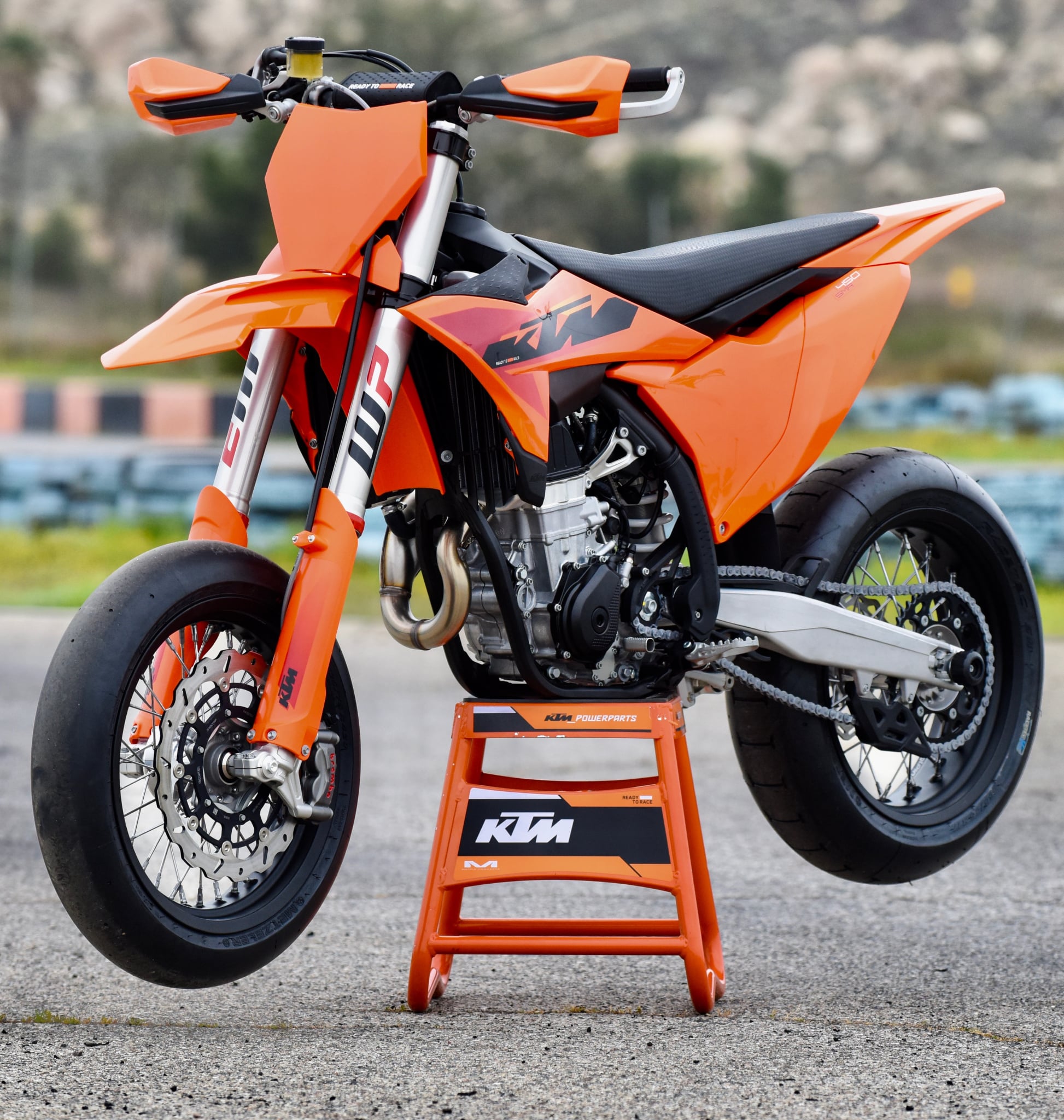 Although a lot like the motocross model, the KTM 450SMR has signifcant differences with the suspension, swingarm, brakes, clutch and wheels.
Although a lot like the motocross model, the KTM 450SMR has signifcant differences with the suspension, swingarm, brakes, clutch and wheels.
WHAT WAS THE BIGGEST DIFFERENCE FROM MOTOCROSS?
I had to learn to trust the grip. In motocross, you’re always riding with some level of drift or slide. The idea of completely planting a bike into a corner without worrying about it sliding is foreign to most dirt riders, but that’s exactly what the SMR encouraged. You could brake later, lean farther and get back on the throttle earlier than you’d ever expect on a regular dirt bike. It took a few sessions for me to stop second-guessing the front end and really lean into the traction it offered.
That said, the dirt sections of the Supermoto layout were a completely different story. The slick tires that worked wonders on pavement weren’t as predictable once we transitioned onto loose dirt. In those areas, I had to go back to my motocross instincts. I found that it worked best to square off the corners, almost stop and turn, and then drive out in a straight line rather than trying to carry momentum like I normally would. This approach helped me stay in control through the dirt and set up properly for the jumps. The goal was always to get the bike back on pavement where it did its best work.
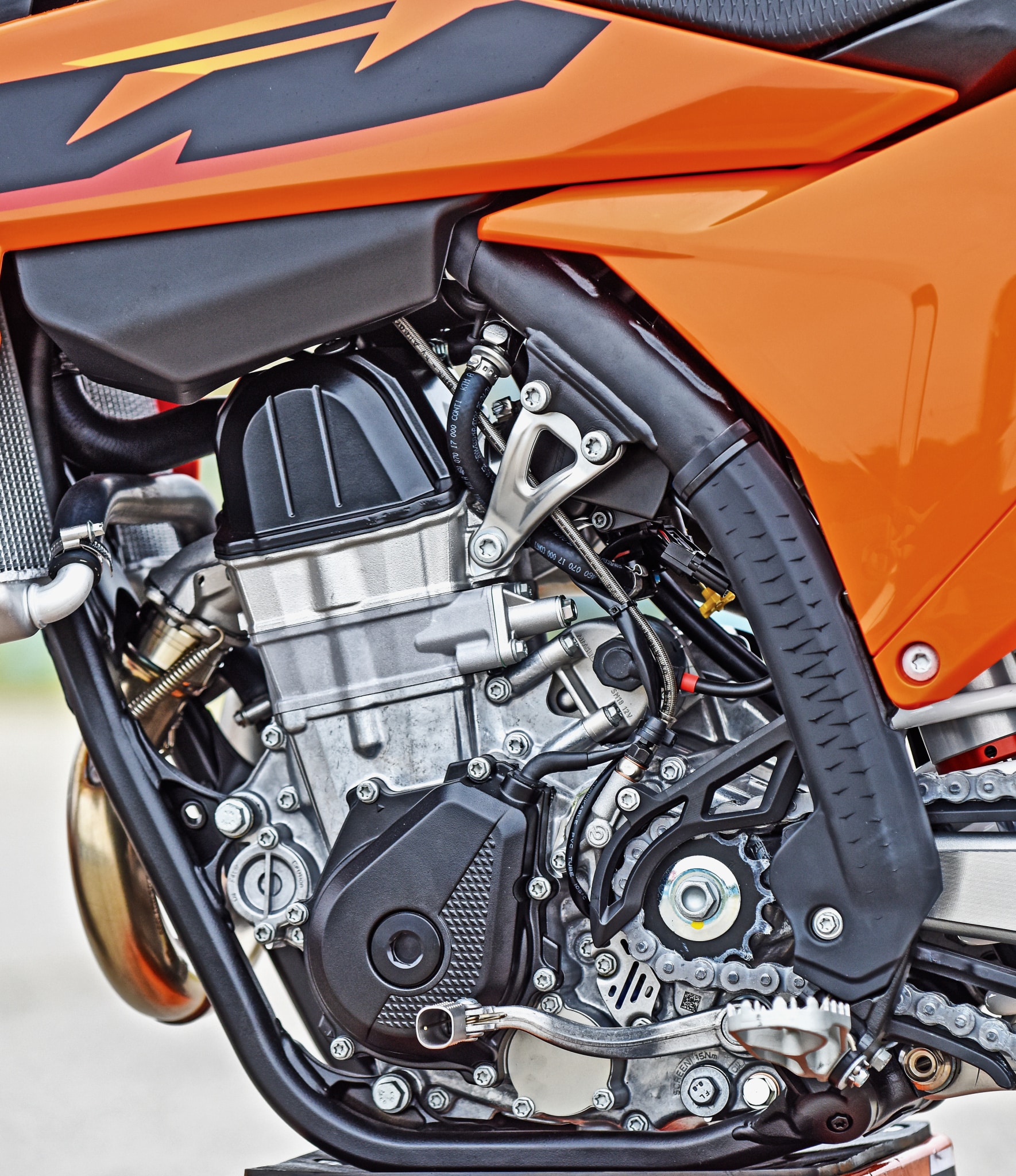 The KTM 450SMR has the same engine as the KTM 450SXF motocross model.
The KTM 450SMR has the same engine as the KTM 450SXF motocross model.
HOW DOES THE SUPERMOTO BIKE FEEL ON THE TRACK?
The KTM 450SMR feels very sharp and reactive. Everything about it is tight, responsive and built to go fast on a hybrid track. The engine delivers smooth, usable power with a broad midrange that works across all sections. It’s easy to keep in the meat of the power without having to shift constantly. The throttle response is instantaneous, and combined with the solid grip, it makes for a setup that gives you a lot of confidence once you get the feel for it.
The braking system is one of the most impressive features of the 450SMR. With a massive 310mm front rotor (compared to 260mm on the 450SXF) and Brembo components, the stopping power is exceptional. You can brake deep into corners without the bike getting twitchy or unstable. The suspension, built around WP components, is stiff and firm like you’d expect from a road racing setup, but it still handles jumps and transitions smoothly. There’s very little flex in the chassis, so what you put in is exactly what you get out.
IT’S A BIKE THAT ANY RACER CAN LEARN FROM. WHETHER YOU’RE COMING FROM MOTOCROSS, DIRT TRACK, ROAD RACING OR JUST LOOKING FOR A NEW CHALLENGE, THE KTM 450SMR OFFERS A PLATFORM THAT REWARDS EFFORT, FOCUS AND PROPER TECHNIQUE.
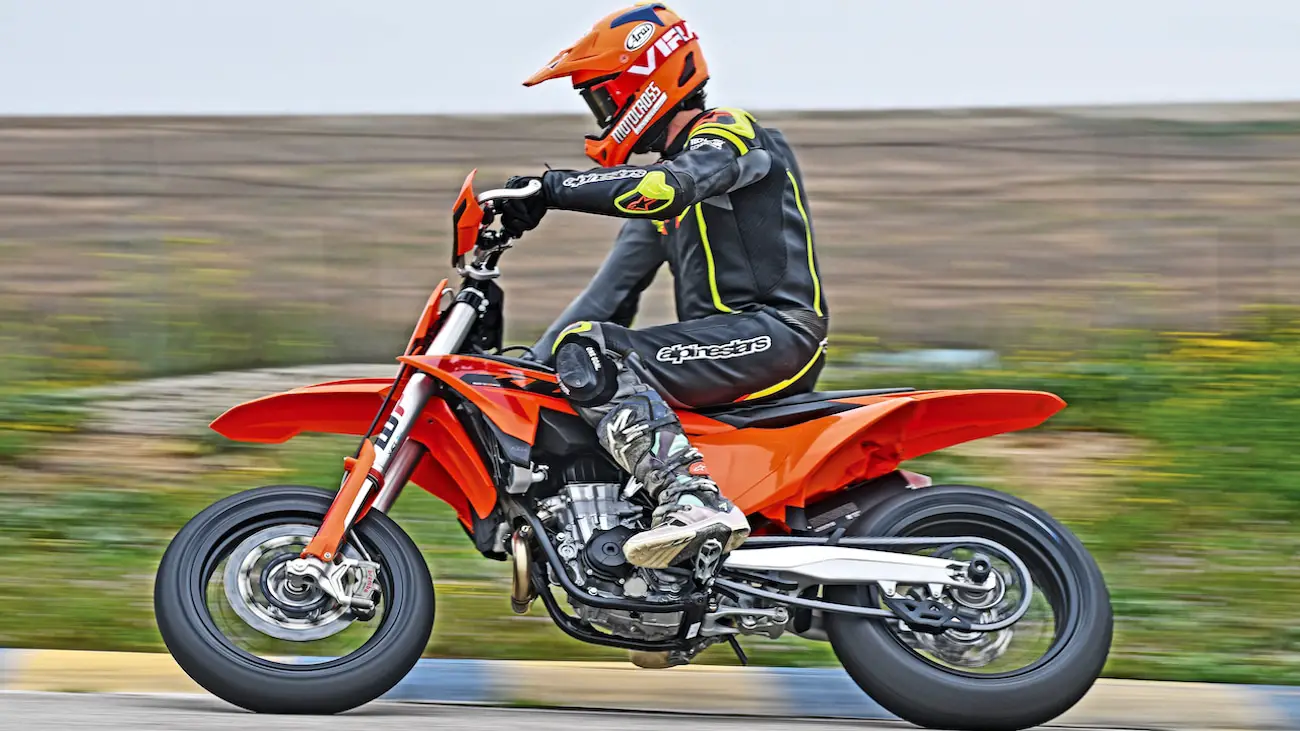
WHAT WAS THE RIDING EXPERIENCE LIKE?
It was one of the most exciting learning experiences I’ve had on a motorcycle in a long time. For a motocrosser, the KTM 450SMR challenges everything you know about racing. It forces you to think differently about traction, cornering and braking. It’s not just about being fast, it’s about being smooth, calculated and precise. Once I stopped fighting my instincts and started adapting to what the bike wanted me to do, it all started to click. Each session got better and better, and by the end of the day, I didn’t want to get off the bike.
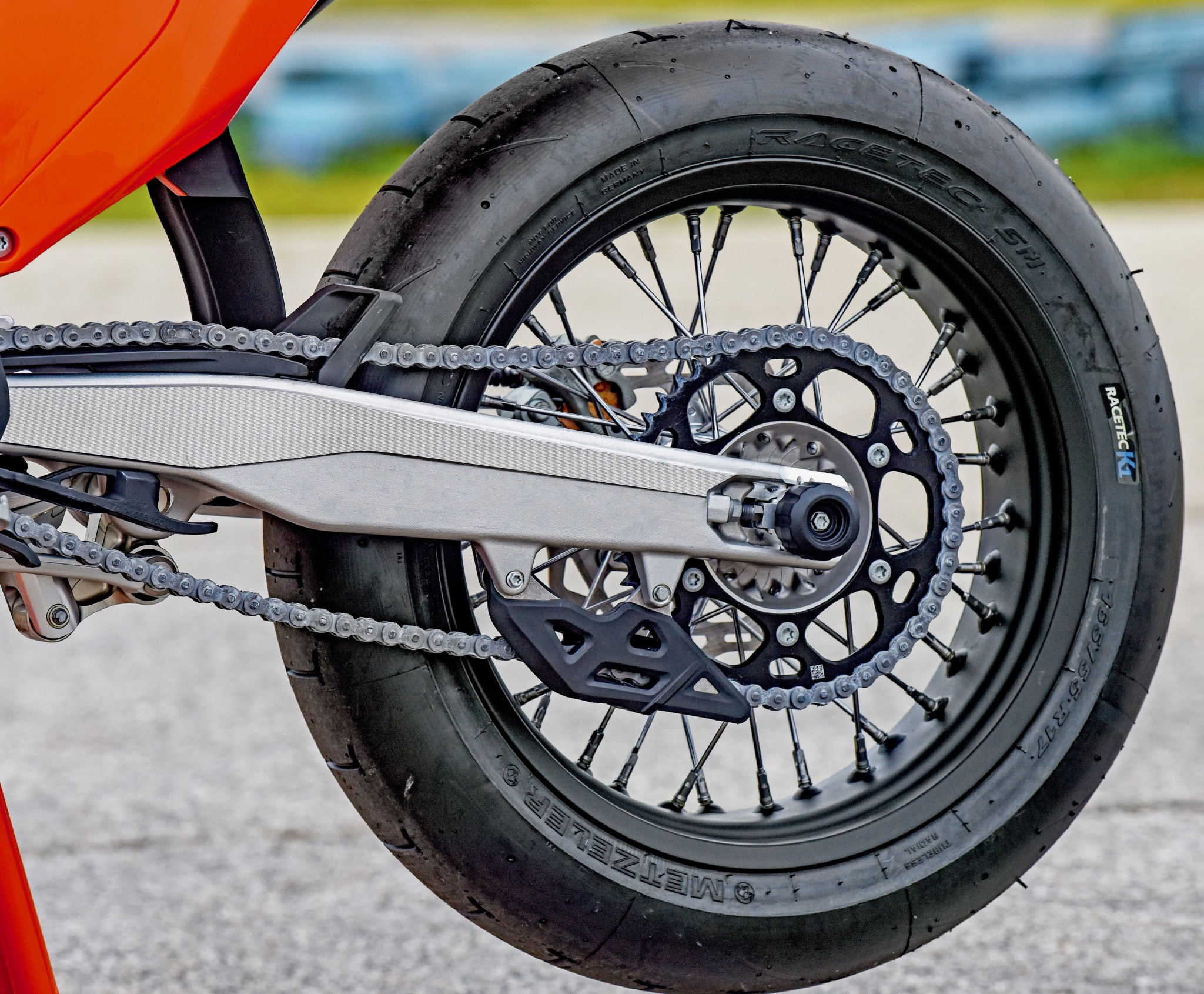 The Metzeler Racetec SM K1 Supermoto pavement rear tire is the opposite of a motocross-ready scoop tire.
The Metzeler Racetec SM K1 Supermoto pavement rear tire is the opposite of a motocross-ready scoop tire.
One thing I didn’t expect was how much of a difference the gear would make. For Supermoto, I wore a full Alpinestars road race suit—leather from head to toe. It was snug, heavy and hot. At first, it felt like I was wearing a weighted vest. The mobility just wasn’t the same as with motocross gear. I couldn’t move around on the bike like I normally would. It took some time to adjust to how tight the arms and shoulders were and how stiff everything felt in the legs. But even with all that, it gave me peace of mind knowing that if I did go down on the pavement, the thick leather would help me slide and keep me protected. That added security helped me build confidence throughout the day, and by the final sessions, I wasn’t thinking about the gear anymore. I was focused on improving my lines and braking zones.

IS SUPERMOTO SOMETHING PEOPLE SHOULD TRY?
Definitely. Supermoto is one of those disciplines that doesn’t get much publicity. It seems to come and go, but it has a lot to offer. It combines the raw feel of motocross with the precision that’s required in road racing. It pushes you to be a better all-around rider. Riding the KTM 450SMR made me appreciate how much technique is involved in road riding. It also reminded me how fun it is to try something new and be a student of the sport again. It’s easy to get comfortable doing what you’ve always done, but stepping outside that box is where the real growth happens.
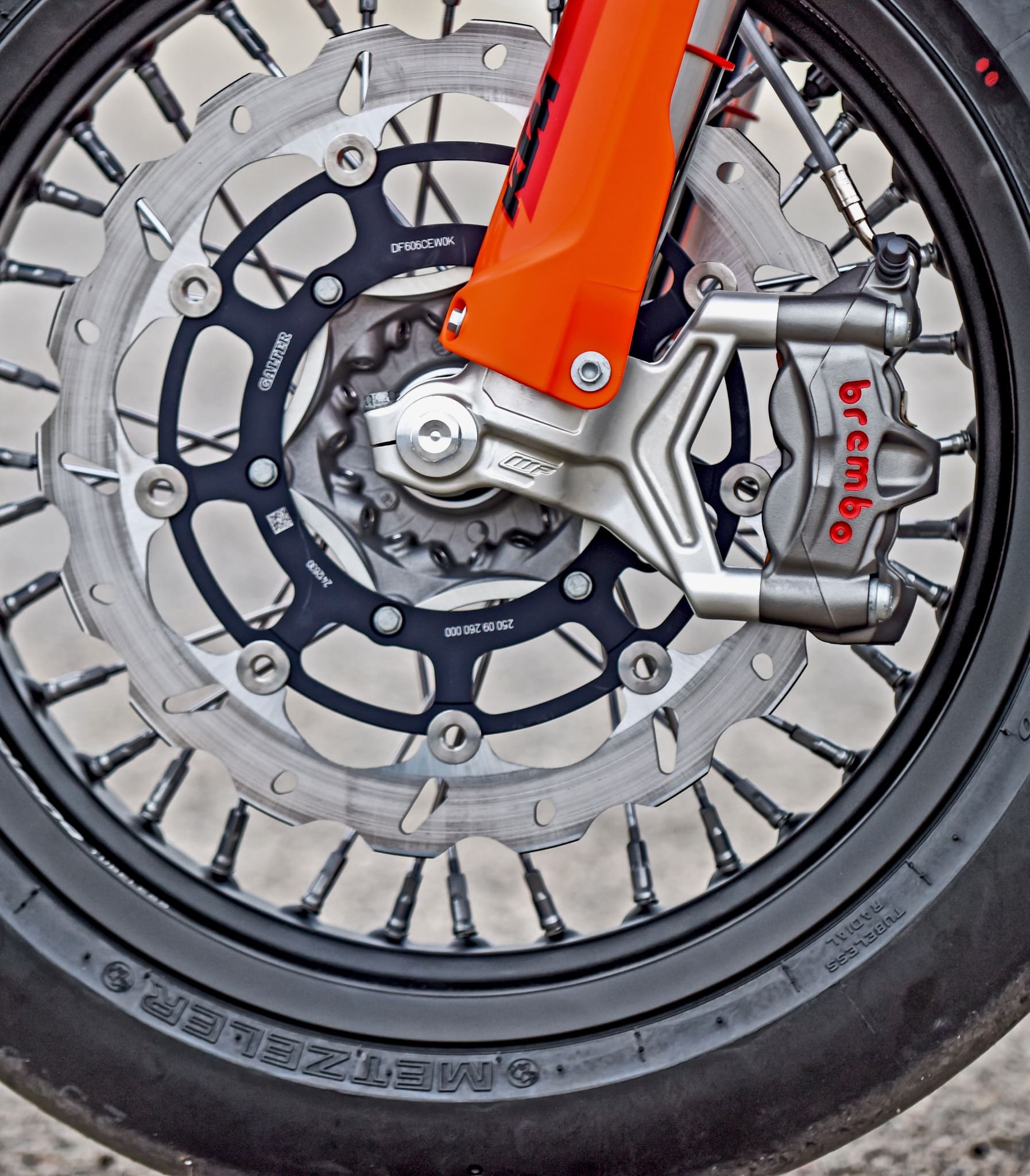 You need all the pucker power possible on pavement. Is the 310mm front rotor enough?
You need all the pucker power possible on pavement. Is the 310mm front rotor enough?
The KTM 450SMR isn’t just a bike for Supermoto specialists, it’s a bike that any racer can learn from. Whether you’re coming from motocross, dirt track, road racing or just looking for a new challenge, the KTM 450SMR offers a platform that rewards effort, focus and proper technique. It’s light, fast and built for one thing—performance. Riding it was a privilege, and it opened my eyes to a whole new world of possibilities on two wheels.
If you’ve ever thought about giving Supermoto a shot, don’t hesitate. You might be surprised how much you learn about yourself, your riding and the machine beneath you. The KTM 450SMR isn’t just another bike, it’s an invitation to push your limits in a completely different way.




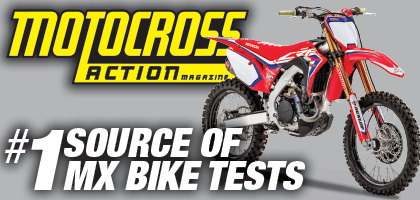


Comments are closed.